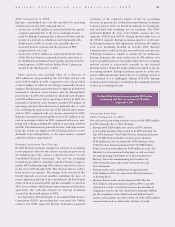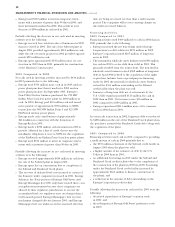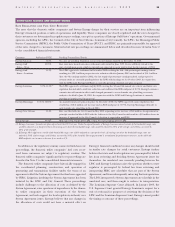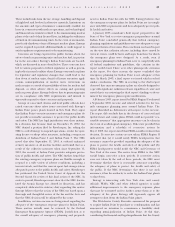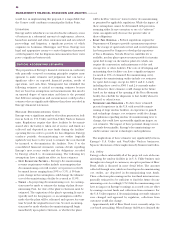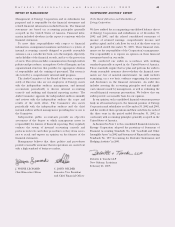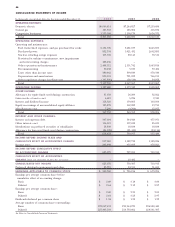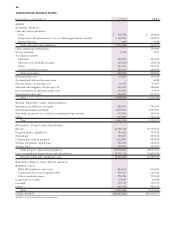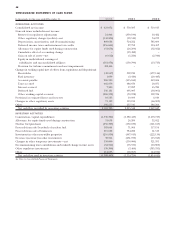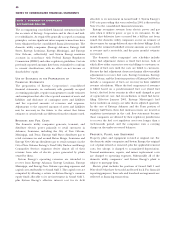Entergy 2002 Annual Report Download - page 42
Download and view the complete annual report
Please find page 42 of the 2002 Entergy annual report below. You can navigate through the pages in the report by either clicking on the pages listed below, or by using the keyword search tool below to find specific information within the annual report.
in 2003 of approximately $520 million as a result of the
discounting methodology required by SFAS 143. Assets
are expected to decrease in 2003 by approximately
$360 million. Earnings are expected to increase by
approximately $160 million as a result of a one-time
cumulative effect of accounting change.
Also, Entergy expects 2003 earnings for the Non-Utility Nuclear
business to increase by approximately $15 million after-tax over
the current level because of the change in accretion of the
liability and depreciation of the associated costs. This effect will
gradually decrease over future years.
IMPAIRMENT OF LONG-LIVED ASSETS
Entergy has significant investments in long-lived assets in all of
its segments, and Entergy evaluates these assets against the
market economics and under the accounting rules for impair-
ment whenever there are indications that impairments may
exist. This evaluation involves a significant degree of estimation
and uncertainty, and these estimates are particularly important
in Entergy’s U.S. Utility and Energy Commodity Services
segments. In the U.S. Utility segment, portions of River Bend
and Grand Gulf are not included in rate base, which could
reduce the revenue that would otherwise be recovered for the
applicable portions of those units’ generation. In the Energy
Commodity Services segment, Entergy’s investments in mer-
chant generation assets are subject to impairment if adverse
market conditions arise.
In order to determine if Entergy should recognize an
impairment of a long-lived asset that is to be held and used,
accounting standards require that the sum of the expected
undiscounted future cash flows from the asset be compared to
the asset’s carrying value. If the expected undiscounted future
cash flows exceed the carrying value, no impairment is record-
ed; if such cash flows are less than the carrying value, Entergy
is required to record an impairment charge to write the asset
down to its fair value. If an asset is held for sale, an impairment
is required to be recognized if the fair value (less costs to sell)
of the asset is less than its carrying value.
These estimates are based on a number of key assumptions,
including:
FUTURE POWER AND FUEL PRICES –Electricity and gas
prices have been very volatile in recent years, and this
volatility is expected to continue for some time. This
volatility necessarily increases the imprecision inherent
in the long-term forecasts of commodity prices that are a
key determinant of estimated future cash flows. There is
currently an oversupply of electricity throughout the U.S.,
and it is necessary to project economic growth and other
macroeconomic factors in order to project when this
oversupply will cease and prices will rise. Similarly, gas
prices have been volatile as a result of recent fluctuations
in both supply and demand, and projecting future trends
in these prices is difficult.
MARKET VALUE OF GENERATION ASSETS –Valuing assets
held for sale requires estimating the current market value
of generation assets. While market transactions provide
evidence for this valuation, the market for such assets is
volatile and the value of individual assets is impacted by
factors unique to those assets.
FUTURE OPERATING COSTS –Entergy assumes relatively
minor annual increases in operating costs. Technological or
regulatory changes that have a significant impact on opera-
tions could cause a significant change in these assumptions.
The carrying value of Entergy’s nonregulated portions of
River Bend and Grand Gulf approximates $1.2 billion at
December 31, 2002. To date, Entergy’s impairment tests have
not required an impairment to be recorded for these assets.
Due to the oversupply of power that existed throughout the
U.S. and the UK in 2002, and the resulting decreases in spark
spreads, consistent with Entergy’s point of view, Entergy’s
impairment tests indicated that a number of impairments
were required to be recognized in 2002 in the Energy
Commodity Services segment. These impairments, which were
also accompanied by other charges related to the restructuring
of Entergy’s independent power business, are further detailed
in Note 12 to the consolidated financial statements.
MARK-TO-MARKET ACCOUNTING
As required by generally accepted accounting principles,
Entergy and Entergy-Koch mark-to-market commodity instru-
ments held by them for trading and risk management purposes
that are considered derivatives under SFAS 133 or energy
trading contracts under Emerging Issues Task Force (EITF) 98-10.
Because of the significant estimates and uncertainties inherent
in mark-to-market accounting, this method is considered a
critical accounting estimate for the Energy Commodity Services
segment. Examples of commodity instruments that are marked
to market include:
commodity futures, options, swaps, and forwards that are
expected to be net settled; and
power sales agreements that do not involve delivery of
power from Entergy’s power plants.
Conversely, commodity contracts that are not considered deriv-
atives or energy trading contracts, generally because they
involve physical delivery of a commodity to the purchaser, are
not marked to market. Examples of commodity contracts that
are not marked to market include:
40
MANAGEMENT’S FINANCIAL DISCUSSION AND ANALYSIS continued
There is currently an oversupply of electricity throughout
the U.S., and it is necessary to project economic growth
and other macroeconomic factors in order to project when
this oversupply will cease and prices will rise.



